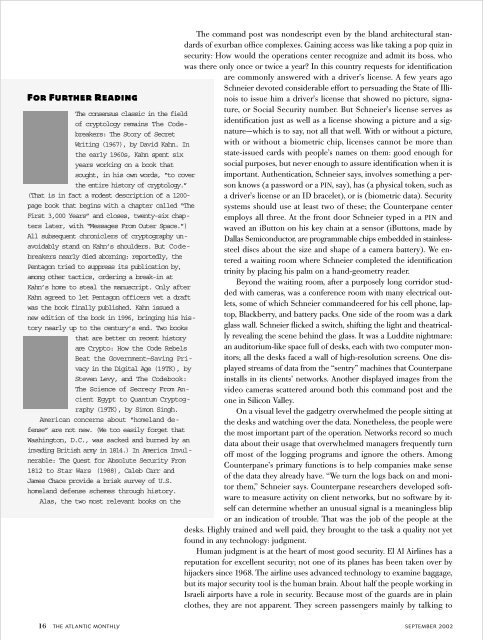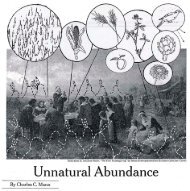HOMELAND INSECURITY - Charles C. Mann
HOMELAND INSECURITY - Charles C. Mann
HOMELAND INSECURITY - Charles C. Mann
Create successful ePaper yourself
Turn your PDF publications into a flip-book with our unique Google optimized e-Paper software.
Sept-Insecurity.pages 6/28/02 10:37 AM Page 16<br />
The command post was nondescript even by the bland architectural standards<br />
of exurban office complexes. Gaining access was like taking a pop quiz in<br />
security: How would the operations center recognize and admit its boss, who<br />
was there only once or twice a year? In this country requests for identification<br />
are commonly answered with a driver’s license. A few years ago<br />
Schneier devoted considerable effort to persuading the State of Illi-<br />
FOR FU RTHER R EADING<br />
nois to issue him a driver’s license that showed no picture, signature,<br />
or Social Security number. But Schneier’s license serves as<br />
The consensus classic in the field<br />
of cryptology remains The Code-<br />
identification just as well as a license showing a picture and a sigbreakers:<br />
The Story of Secret<br />
nature—which is to say, not all that well. With or without a picture,<br />
Writing (1967), by David Kahn. In with or without a biometric chip, licenses cannot be more than<br />
the early 1960s, Kahn spent six state-issued cards with people’s names on them: good enough for<br />
years working on a book that<br />
social purposes, but never enough to assure identification when it is<br />
sought, in his own words, “to cover important. Authentication, Schneier says, involves something a per-<br />
the entire history of cryptology.” son knows (a password or a PIN, say), has (a physical token, such as<br />
(That is in fact a modest description of a 1200- a driver’s license or an ID bracelet), or is (biometric data). Security<br />
page book that begins with a chapter called “The systems should use at least two of these; the Counterpane center<br />
First 3,000 Years” and closes, twenty-six chap- employs all three. At the front door Schneier typed in a PIN and<br />
ters later, with “Messages From Outer Space.”) waved an iButton on his key chain at a sensor (iButtons, made by<br />
All subsequent chroniclers of cryptography un- Dallas Semiconductor, are programmable chips embedded in stainlessavoidably<br />
stand on Kahn’s shoulders. But Codesteel<br />
discs about the size and shape of a camera battery). We enbreakers<br />
nearly died aborning: reportedly, the<br />
tered a waiting room where Schneier completed the identification<br />
Pentagon tried to suppress its publication by,<br />
trinity by placing his palm on a hand-geometry reader.<br />
among other tactics, ordering a break-in at<br />
Beyond the waiting room, after a purposely long corridor stud-<br />
Kahn’s home to steal the manuscript. Only after<br />
ded with cameras, was a conference room with many electrical out-<br />
Kahn agreed to let Pentagon officers vet a draft<br />
lets, some of which Schneier commandeered for his cell phone, lap-<br />
was the book finally published. Kahn issued a<br />
new edition of the book in 1996, bringing his histop, Blackberry, and battery packs. One side of the room was a dark<br />
tory nearly up to the century’s end. Two books glass wall. Schneier flicked a switch, shifting the light and theatrical-<br />
that are better on recent history ly revealing the scene behind the glass. It was a Luddite nightmare:<br />
are Crypto: How the Code Rebels an auditorium-like space full of desks, each with two computer mon-<br />
Beat the Government—Saving Priitors; all the desks faced a wall of high-resolution screens. One disvacy<br />
in the Digital Age (19TK), by played streams of data from the “sentry” machines that Counterpane<br />
Steven Levy, and The Codebook: installs in its clients’ networks. Another displayed images from the<br />
The Science of Secrecy From An- video cameras scattered around both this command post and the<br />
cient Egypt to Quantum Cryptog- one in Silicon Valley.<br />
raphy (19TK), by Simon Singh.<br />
On a visual level the gadgetry overwhelmed the people sitting at<br />
American concerns about “homeland de-<br />
the desks and watching over the data. Nonetheless, the people were<br />
fense” are not new. (We too easily forget that<br />
the most important part of the operation. Networks record so much<br />
Washington, D.C., was sacked and burned by an<br />
data about their usage that overwhelmed managers frequently turn<br />
invading British army in 1814.) In America Invul-<br />
off most of the logging programs and ignore the others. Among<br />
nerable: The Quest for Absolute Security From<br />
Counterpane’s primary functions is to help companies make sense<br />
1812 to Star Wars (1988), Caleb Carr and<br />
of the data they already have. “We turn the logs back on and moni-<br />
James Chace provide a brisk survey of U.S.<br />
tor them,” Schneier says. Counterpane researchers developed soft-<br />
homeland defense schemes through history.<br />
Alas, the two most relevant books on the<br />
ware to measure activity on client networks, but no software by itself<br />
can determine whether an unusual signal is a meaningless blip<br />
or an indication of trouble. That was the job of the people at the<br />
desks. Highly trained and well paid, they brought to the task a quality not yet<br />
found in any technology: judgment.<br />
Human judgment is at the heart of most good security. El Al Airlines has a<br />
reputation for excellent security; not one of its planes has been taken over by<br />
hijackers since 1968. The airline uses advanced technology to examine baggage,<br />
but its major security tool is the human brain. About half the people working in<br />
Israeli airports have a role in security. Because most of the guards are in plain<br />
clothes, they are not apparent. They screen passengers mainly by talking to<br />
16 THE ATLANTIC MONTHLY SEPTEMBER 2002




